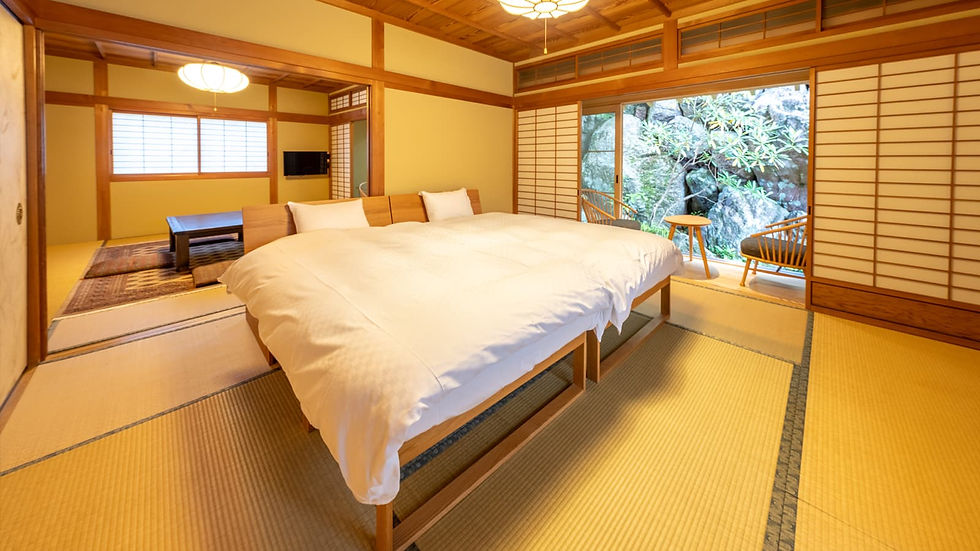The Backpacker who Became a Monk
- India Gustin
- May 16
- 4 min read
Updated: May 20
“I never wanted to be a monk,” says Nori, a monk of six years in one of Japan’s most sacred mountain towns and the ecclesiastical headquarters of Shingon Buddhism. Yet after spending some time in Koyasan, a UNESCO World Heritage site, he had no choice but to start his two-year training. The region is known for its temples, Buddhist activities and most interestingly of all (at least for the curious traveller seeking complete cultural immersion), its temple lodgings.

Koyasan, also known as Mount Koya, is a sacred mountain in Japan’s Wakayama Prefecture. It is also where a monk called Kōbō Daishi founded a major school of Japanese Esoteric Buddhism, Shingon. Back in 816 AD, Kōbō Daishi received imperial permission to establish a monastic complex on Mount Koya. He chose this remote, forested plateau surrounded by eight mountain peaks as the ideal site for this meditative retreat. It coincidentally also resembled a lotus flower. The area was secluded and difficult to access, which suited the spiritual purpose of intense esoteric practice, away from worldly distractions.
There are 117 temples in Koyasan, 50 of which are known as Shukubo. The term refers to temple lodgings. Traditionally they were accommodations within temples for monks and later nobles and even samurais. Originally, these lodging spaces were created for visiting monks, ascetics, and devotees undertaking religious pilgrimages to Koyasan. The monks who lived on Koyasan maintained these lodgings and provided the necessary hospitality as part of their religious service. “In Japanese Buddhism there is a feature that we value a lot,” explains Nori, “and that is compassion. Helping and hosting people is a part of monk training.”

Nori has lived in Koyasan for the past eight years, six of which he has spent as a monk. More specifically, he works at Ekoin, a temple lodging which is about 1,200 years old. Whilst these Shukubo — and Koyasan in general — remained an isolated religious site for many centuries, the Edo Period saw an influx of pilgrims and travellers looking for a place to stay. The temples therefore gradually opened up their doors to the non-clergy and have overtime become more organised and structured. Now, they are a major aspect of spiritual and cultural tourism in the region.
Of course, one of main differences between a typical accommodation and a Shukubo is the Buddhism element. Setting aside that you’re residing in a sacred temple which is centuries-old, the whole affair is kept authentic and true to religion. Whilst these temple lodgings are open to international travellers looking to experience something different, it is important to remember that the institution remains a sacred place. Locals and visitors alike still come to pray for their ancestors by partaking in daily ceremonies.

In fact, Ekoin holds daily Buddhist activities such as the morning ceremony (a memorial service for the deceased and ancestors) as well as the infamous goma fire ritual (to celebrate the living). Additionally, they offer the traditional Japanese Buddhist cuisine, Shojin ryori. As a basis, this traditional dining style is vegetarian and in most cases, vegan. From traditional bathing rooms and meditation dojos, this temple lodging emulates the religion’s long-standing practices to allow for curios travellers to experience for themselves.

Surprisingly enough, Nori wasn’t exactly set on travelling to Koyasan to train as a monk. Quite the opposite. “I never wanted to be a monk,” he admits. “I wasn’t even supposed to stay here long.” Actually, he used to be a backpacker, moving around through Asia and even Australia where he spent six months in Tasmania.
When he returned to Japan, he was asked by his monk friend to visit him in Koyasan. "I just came to stay as a guest to visit him,” he recalls. That is when he remembered all the empathy and kindness he himself received from strangers whilst travelling. Deciding to want to give back to the universe, he decided to stay. “The more I stayed here, the more I was getting inspired by these teachings,” says Nori. “After spending two years here, I really couldn’t help but become a monk,” he laughs.
Whilst Buddhist teachings vary slightly from country to country, Koyasan remains a sacred place where this religion can thrive. Obviously, the region is more than just a scenic mountain retreat. It is a living, breathing testament to centuries of spiritual devotion and human connection. Through the sacred practices of temple life, the century-old rituals and the enduring hospitality of Shukubo monks, visitors are invited to learn about this peaceful culture. Nori’s story embodies this shift — from curious traveller to devoted monk — echoing Koyasan’s own transformation from a secluded monastic haven to actively connecting ancient teachings with modern seekers.



Comments